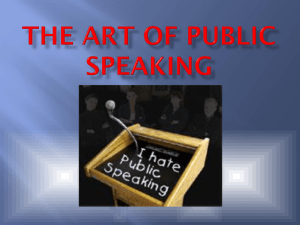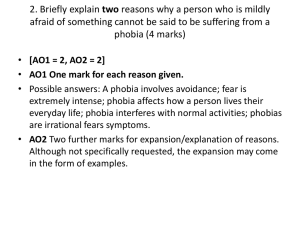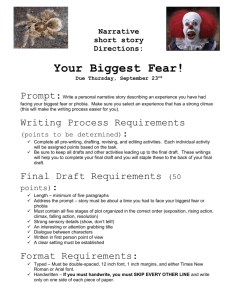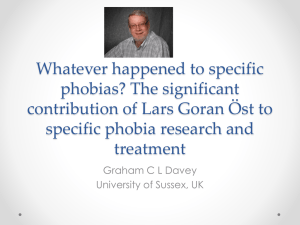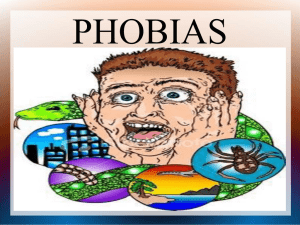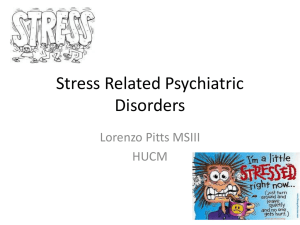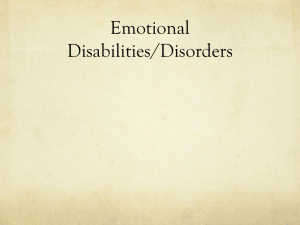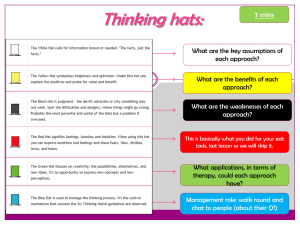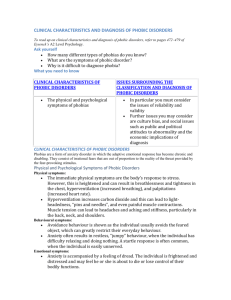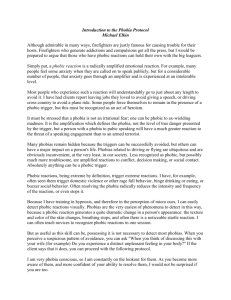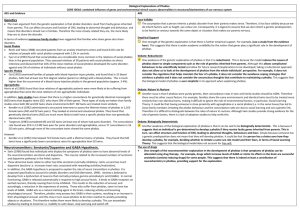Drug therapy has seldom been used in the treatment of
advertisement
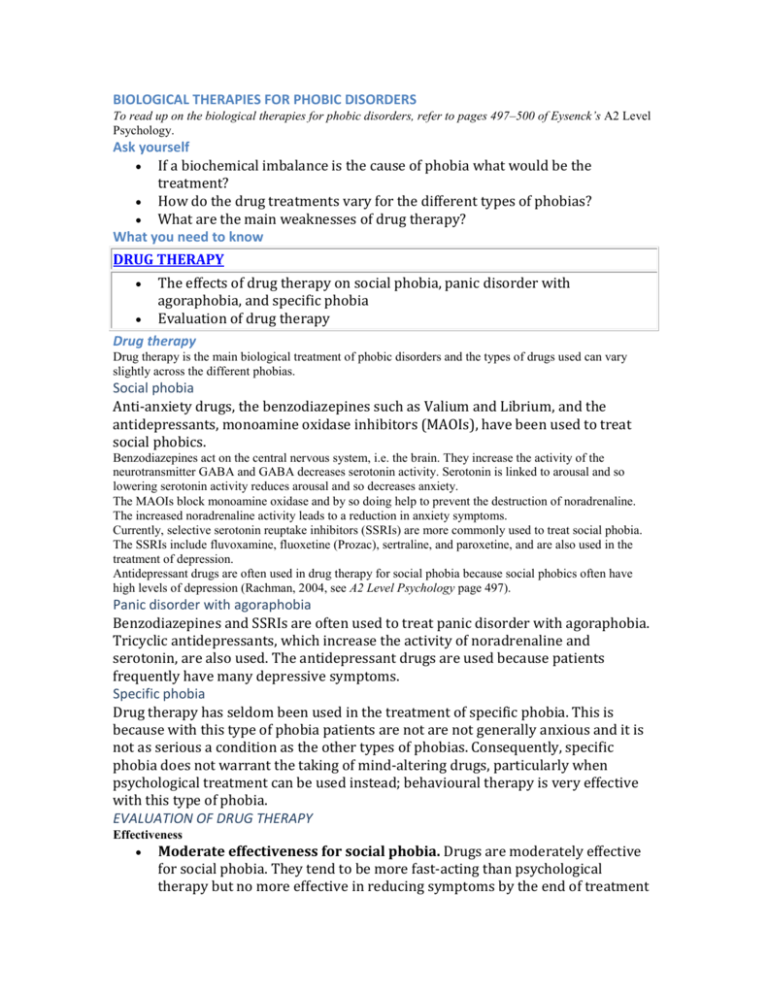
BIOLOGICAL THERAPIES FOR PHOBIC DISORDERS To read up on the biological therapies for phobic disorders, refer to pages 497–500 of Eysenck’s A2 Level Psychology. Ask yourself If a biochemical imbalance is the cause of phobia what would be the treatment? How do the drug treatments vary for the different types of phobias? What are the main weaknesses of drug therapy? What you need to know DRUG THERAPY The effects of drug therapy on social phobia, panic disorder with agoraphobia, and specific phobia Evaluation of drug therapy Drug therapy Drug therapy is the main biological treatment of phobic disorders and the types of drugs used can vary slightly across the different phobias. Social phobia Anti-anxiety drugs, the benzodiazepines such as Valium and Librium, and the antidepressants, monoamine oxidase inhibitors (MAOIs), have been used to treat social phobics. Benzodiazepines act on the central nervous system, i.e. the brain. They increase the activity of the neurotransmitter GABA and GABA decreases serotonin activity. Serotonin is linked to arousal and so lowering serotonin activity reduces arousal and so decreases anxiety. The MAOIs block monoamine oxidase and by so doing help to prevent the destruction of noradrenaline. The increased noradrenaline activity leads to a reduction in anxiety symptoms. Currently, selective serotonin reuptake inhibitors (SSRIs) are more commonly used to treat social phobia. The SSRIs include fluvoxamine, fluoxetine (Prozac), sertraline, and paroxetine, and are also used in the treatment of depression. Antidepressant drugs are often used in drug therapy for social phobia because social phobics often have high levels of depression (Rachman, 2004, see A2 Level Psychology page 497). Panic disorder with agoraphobia Benzodiazepines and SSRIs are often used to treat panic disorder with agoraphobia. Tricyclic antidepressants, which increase the activity of noradrenaline and serotonin, are also used. The antidepressant drugs are used because patients frequently have many depressive symptoms. Specific phobia Drug therapy has seldom been used in the treatment of specific phobia. This is because with this type of phobia patients are not are not generally anxious and it is not as serious a condition as the other types of phobias. Consequently, specific phobia does not warrant the taking of mind-altering drugs, particularly when psychological treatment can be used instead; behavioural therapy is very effective with this type of phobia. EVALUATION OF DRUG THERAPY Effectiveness Moderate effectiveness for social phobia. Drugs are moderately effective for social phobia. They tend to be more fast-acting than psychological therapy but no more effective in reducing symptoms by the end of treatment (Heimberg et al., 1998, see A2 Level Psychology page 498). Similarly, Bandelow et al. (2007, see A2 Level Psychology page 498) reviewed six studies in which drug therapy was compared with psychological forms of therapy in the treatment of social phobia. Drug and psychological therapy both led to similar substantial improvements. Moderate effectiveness for agoraphobia with panic disorder. Mitte (2005, see A2 Level Psychology page 498) reported a meta-analysis focusing on the effectiveness of benzodiazepines, SSRIs, and tricyclics. The different drugs were equally effective in treating panic disorder with agoraphobia. A multi-dimensional approach. Mitte (2005, see above point) found that combining drug therapy and cognitive or cognitive-behavioural therapy increased the effectiveness of treatment. However, note Marks et al.’s (1993, see A2 Level Psychology pages 498–499) findings under relapse rates, as these show that a combined approach is not always the most effective treatment of agoraphobia. No more effective than cognitive or CBT therapy. Mitte found drugs to be no more effective in reducing symptoms than the psychological therapies, and in other respects the psychological therapies are better. Drop-out rate. Mitte found the drop-out rate was significantly higher for drug therapy than for cognitive or cognitive-behavioural therapy (20% vs. 15%). Relapse rates. Drugs compare unfavourably to psychological treatments in terms of relapse rates and so their effects are not as long-lasting. Liebowitz et al. (1999, see A2 Level Psychology page 498) followed up on the patients studied by Heimberg et al. (1998, see above). None of those receiving cognitive-behavioural therapy for social phobia suffered a relapse during the following 6-month period compared to 33% of the patients who had received drug therapy. Marks et al. (1993, see A2 Level Psychology pages 498–499) found the benefits of drug therapy for agoraphobia were short term as over a 6-month period patients fared better if they had just been treated with exposure therapy, than when they had been treated with a benzodiazepine, or the two therapies combined. Treats symptoms not causes. The relapse rates suggest drugs just treat the symptoms, not the underlying causes, of phobias, and so drug therapy is palliative (manages the disorder) rather than a curative treatment. Placebo effect. The placebo effect occurs when patients given an inactive substance or placebo (e.g. a salt tablet) show significant reductions in their symptoms. It is difficult to know how much any improvement is due to the drug and how much to the placebo effect, i.e. the patient improves because they expect the drug to work. Appropriateness Reduces anxiety. Most patients with phobias are very concerned or distressed at the extreme levels of anxiety they experience and drugs successfully reduce that anxiety. Fast-acting. Many patients find that drug therapy is appropriate because the drugs act quickly and effectively. Effects are short-lived. The symptom reduction obtained is often lost very quickly afterwards. The main effect of drug therapy is to suppress phobic patients’ symptoms, and this suppression effect stops when drug treatment comes to an end. Palliative not curative. Drug therapy treats symptoms not the underlying causes and so does not cure phobia. Side effects. All the drugs used in the treatment of phobias possess unwanted side effects. For example, the SSRIs can cause insomnia, reduced sex drive, and nausea; tricyclics can cause blurred vision, dry mouth, and dizziness; the benzodiazepines can cause drowsiness and lethargy; and the MAOIs can block the production of monoamine oxidase in the liver, leading to an accumulation of tyramine and increased blood pressure. Drop-out rate. The fact the drop-out rate is higher than for psychological therapies questions appropriateness. <SAD BULLET>Lack understanding of their effect. We do not fully understand how the different drugs reduce the symptoms of phobia. It is not as simple as them increasing neurotransmitter levels because they do this almost instantly, but can take a few weeks to have an effect. Some would argue we shouldn’t use them if we do not fully understand how they work. Compare unfavourably to psychological treatment. The fact that patients treated with cognitive therapy have lower relapse rates suggests that cognitive therapy may be more appropriate than drug therapy, particularly given that cognitive therapy is far less invasive as it does not have the side effects of drug therapy. So what does this mean? Drug therapy has the strength of being fast-acting and reasonably effective in the treatment of phobias, at least in the short term. However, the length of any improvement is a key issue, as research suggests the improvement lasts only as long as patients stay on the drugs, and of course being on drugs is not a permanent solution! Furthermore, all biological treatments raise issues of appropriateness such as side effects, and the fact they treat the symptoms not the causes, which leads to a high relapse rate. This last criticism is a key weakness as this makes biological treatments palliative, because they manage the disorder rather than cure it, and so we need to consider if psychological treatments offer more hope of a cure. Evidence suggests that this is the case as drugs have been compared negatively to cognitive and cognitive-behavioural therapies. But, on the other hand, some patients may need drug therapy to calm them down to a state in which they can benefit from psychological therapy. Over to you (a) Outline one or more biological therapy(ies) for one anxiety disorder. (9 marks) (b) Evaluate the therapy(ies) described in (a). (16 marks)
